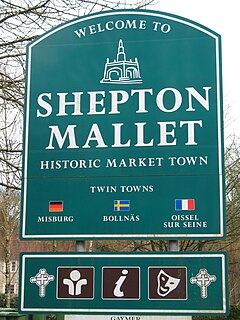Shepton Mallett
| Shepton Mallet | |
|---|---|
 Welcome sign |
|
| Shepton Mallet shown within Somerset | |
| Population | 10,369 (2011) |
| OS grid reference | ST619438 |
| • London | 106 mi (171 km) E |
| District | |
| Shire county | |
| Region | |
| Country | England |
| Sovereign state | United Kingdom |
| Post town | SHEPTON MALLET |
| Postcode district | BA4 |
| Dialling code | 01749 |
| Police | Avon and Somerset |
| Fire | Devon and Somerset |
| Ambulance | South Western |
| EU Parliament | South West England |
| UK Parliament | |
Shepton Mallet is a town and civil parish in the Mendip district of Somerset in South West England. Situated approximately 18 miles (29 km) south of Bristol and 5 miles (8.0 km) east of Wells, the town is estimated to have a population of 10,369. It contains the administrative headquarters of Mendip District Council.
The Mendip Hills lie to the north, and the River Sheppey runs through the town. Shepton Mallet lies on the route of the Fosse Way, the principal Roman road into the south west of England, and there is evidence of Roman settlement. The town contains a fine parish church and a considerable number of listed buildings. Shepton Mallet Prison was England's oldest prison still in use until its closure in March 2013.
In medieval times, the wool trade was important in the town's economy, although this declined in the 18th century to be replaced by other industries such as brewing; the town continues to be a major centre for the production of cider. Shepton Mallet is the closest town to the site of the Glastonbury Festival, the largest music festival in Europe. Also nearby is the Royal Bath and West of England Society showground which hosts the Royal Bath and West Show, and other major shows and festivals.
The name Shepton derives from the Old English scoep and tun, meaning 'sheep farm'; the Domesday Book of 1086 records a settlement known as Sceaptun. The current spelling is recorded at least as far back as 1496, in a letter from Henry VII. The second part of the name derives from that of the Norman Malet family who took a lease from Glastonbury Abbey around 1100. The second 'L' appears to have been added in the 16th century.
...
Wikipedia

